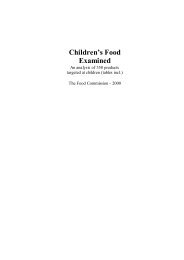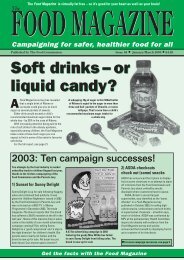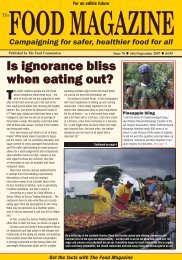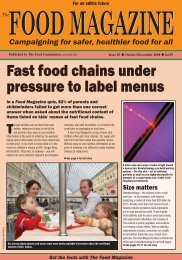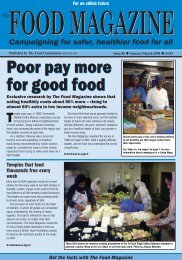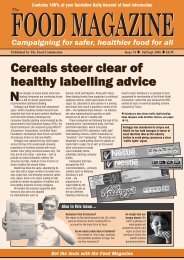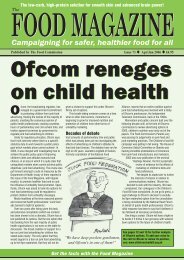Children's Nutrition Action Plan - The Food Commission
Children's Nutrition Action Plan - The Food Commission
Children's Nutrition Action Plan - The Food Commission
Create successful ePaper yourself
Turn your PDF publications into a flip-book with our unique Google optimized e-Paper software.
• In one of the home-based studies with ‘fussy eaters’ (aged 5-6 years), children’s consumption of<br />
targeted fruit rose from 4% to 100%, and of targeted vegetables from 1% to 83%. Targeted fruit<br />
consumption was still at 100%, and vegetable consumption at 58%, when the children were<br />
observed again six months later.<br />
• In day-care nursery settings results were equally impressive. In one study, for example, lunchtime<br />
vegetable consumption rose from 20% to 89% and, in the case of fruit, from an initial 17% to<br />
76% fifteen months later.<br />
• In primary-school settings, the effects on children’s diets were similarly strong and long lasting.<br />
Even when popular sweet and savoury snacks were presented alongside the fruit and vegetables,<br />
fruit consumption of 5-6 year olds more than doubled from an initial level of 28% to 59% six<br />
months later, while vegetable consumption rose four-fold, from 8% to 32%.<br />
• Successive studies demonstrated that these positive effects were not limited to foods experienced<br />
during the programme, but spread to a wide range of other fruit and vegetables.<br />
• Similarly, the positive effects were found to be general across contexts. For example, in the case<br />
of the school studies, it was found that the effects extended beyond the school context into the<br />
home environment and, in the nursery setting, from snack-time to lunchtime.<br />
HEALTH EA TING AT S C HOOL PRO JEC T<br />
A new large-scale project (begun in January, 1999) aims to develop the learning programme as a selfcontained<br />
whole-school package that can be administered autonomously by primary schools<br />
themselves across the full age range of their pupils. <strong>The</strong> project is funded by the Horticultural<br />
Development Council, the Fresh Produce Consortium, ASDA, the Co-operative Wholesale Society,<br />
Safeway, Sainsbury’s, Somerfield, T esco and Birds Eye Wall’s and is monitored by a Steering<br />
Committee that includes representatives from the Departments of Health and Education, the Ministry<br />
for Agriculture, Fisheries and <strong>Food</strong> and the <strong>Food</strong> Standards Agency.<br />
New procedures and materials, including videos and educational materials, have been developed and<br />
tested in primary schools in Harwell (Oxfordshire), Bangor (Gwynedd), Salford (Manchester),<br />
Brixton (Lambeth) and Stockwell (Lambeth); over 1,00 children aged 4-11 have participated. <strong>The</strong><br />
Stockwell school acted as a control school in which fruit and vegetable consumption without the<br />
learning programme was measured. In all schools children were presented with fruit and vegetables at<br />
lunchtime and fruit and/or vegetables at ‘snack-time’ (immediately prior to morning break). <strong>The</strong><br />
learning programme was then introduced in those schools selected for the intervention, and in all of<br />
them this resulted in very significant increases in pupils’ fruit and vegetable consumption. For<br />
instance, in Harwell, at snack-time it rose from 47% to 83% for fruit and from 37% to 77% for<br />
vegetables, and at lunchtime, from 46% to 82% for fruit and from 29% to 84% for vegetables. Some<br />
of the largest percentage increases were seen in the most socially deprived areas. For example, in<br />
Salford, lunchtime consumption of fruit increased by 150% (to 38g) and of vegetables by 315% (to<br />
33g). Similarly, in the Bangor and Brixton schools there were substantial increases in consumption,<br />
particularly at lunchtime. On the other hand, in the Stockwell control school, where the learning<br />
programme was not introduced, no increases in fruit and vegetable consumption occurred either at<br />
snack-time or lunchtime.<br />
Parents responded very positively to the programme. Almost all those who completed a postintervention<br />
questionnaire said they believed their children had benefited from taking part in it. Over<br />
80% reported that their child had started to eat more fruit and vegetables at home and most of these<br />
also said that their child had asked them to buy additional fruits and vegetables. Teachers were<br />
equally enthusiastic, not only because of the programmes’ beneficial effects on pupils’ diets, but also<br />
because it boosted pupils’ interest in related aspects of the curriculum and increased school<br />
attendance. An important feature of the programme is the provision of a <strong>Food</strong> Dude Educational<br />
Materials pack designed to assist teachers to achieve national curriculum targets in English,<br />
mathematics and science, drawing upon the enthusiasm generated by the programme. (For additional<br />
<strong>The</strong> Children’s <strong>Nutrition</strong> <strong>Action</strong> <strong>Plan</strong>, published by <strong>The</strong> <strong>Food</strong> <strong>Commission</strong><br />
23



